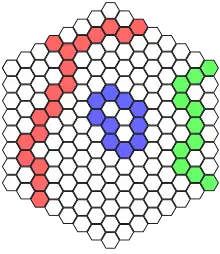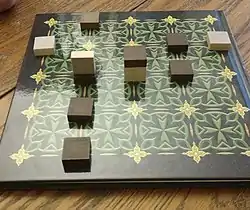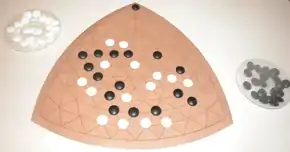Connection game
A connection game is a type of abstract strategy game in which players attempt to complete a specific type of connection with their pieces. This could involve forming a path between two or more goals, completing a closed loop, or connecting all of one's pieces so they are adjacent to each other.[1] Connection games typically have simple rules, but complex strategies. They have minimal components and may be played as board games, computer games, or even paper and pencil games.
In many connection games, the goal is to connect two opposite sides of the board. In these games, players take turns placing or moving pieces until one side has a continuous line of pieces connecting the two sides of the playing area. Hex, TwixT, and PÜNCT are typical examples of this type of game.
Popular connection games

Havannah
Havannah is a two-player abstract strategy board game invented by Christian Freeling. Unlike Hex or other connection games, Havannah has three goals that a player strives for, creating a Fork, a Bridge, or a Ring. The achievement of any one of them results in victory. A ring is a loop around one or more cells regardless of whether or not the encircled cells are occupied by any player or empty. A bridge connects any two of the six corner cells of the board. And finally a fork connects any three edges of the board (a corner point is not considered part of an edge). Havannah has "a sophisticated and varied strategy" and is best played on a base-10 hexagonal board, 10 hex cells to a side.[2]
The game was published for a period in Germany by Ravensburger, with a smaller, base-8 board suitable for beginners. It is nowadays only produced by Hexboards.[3]
Hex
.jpg.webp)
Hex is a two player abstract strategy board game in which players attempt to connect opposite sides of a hexagonal board. Hex was invented by mathematician and poet Piet Hein in 1942 and independently by John Nash in 1948.
It is traditionally played on an 11×11 rhombus board, although 13×13 and 19×19 boards are also popular. Each player is assigned a pair of opposite sides of the board which they must try to connect by taking turns placing a stone of their color onto any empty space. Once placed, the stones are unable to be moved or removed. A player wins when they successfully connect their sides together through a chain of adjacent stones. Draws are impossible in Hex due to the topology of the game board.
The game has deep strategy, sharp tactics and a profound mathematical underpinning related to the Brouwer fixed-point theorem. The game was first marketed as a board game in Denmark under the name Con-tac-tix, and Parker Brothers marketed a version of it in 1952 called Hex; they are no longer in production. Hex can also be played with paper and pencil on hexagonally ruled graph paper.
Tak

Tak is a two-player abstract strategy game designed by James Ernest and Patrick Rothfuss and published by Cheapass Games in 2016. Its design was based around the fictional game of Tak described in Patrick Rothfuss' 2011 fantasy novel The Wise Man's Fear.[4]
The goal of Tak is to be the first to connect two opposite edges of the board with your pieces, called "stones", and create a road. To accomplish this, players take turns placing their own stones and building their road while blocking and capturing their opponent's pieces to hinder their efforts at the same. A player "captures" a stone by stacking one of their pieces on top of the opponent's. This creates a three dimensional element to the game play absent in other well known connection games, such as hex. In addition the player may place and move a piece called the capstone or play normal stones "standing" up on their edge. The capstone and standing stones have different powers and rules regarding their use in the game.
The Game of Y

Y is an abstract strategy board game, first described by John Milnor in the early 1950s.[5][6][7] The goal of Y is similar to Hex except that each player has the identical goal of making a connection between all three sides forming a "Y" rather than "owning" specific sides that must be connected. The game was independently invented in 1953 by Craige Schensted and Charles Titus. It is an early member in a long line of games Schensted has developed, each game more complex but also more generalized.
List of connection games
- Bridg-It, also called Gale
- Crosstrack
- Dots
- Gonnect
- Havannah
- Hex, also called Con-tac-tix, Nash, or Polygon
- Lines of action
- Onyx
- PÜNCT
- Selfo
- Shannon switching game
- Star
- *Star
- Tak
- Through the Desert
- Trax
- TwixT
- Y
See also
- Combinatorial game theory
- Mathematical games
References
- Browne, C. (2005). Connection Games: Variations on a Theme. Wellesley, MA: A. K. Peters, Ltd.
- Handscomb, Kerry, ed. (Winter 2002). "Front Cover". Abstract Games. Carpe Diem Publishing (12). ISSN 1492-0492.
- Hexboards
- "Kickstarting Tak, a new Cheapass Game based on Patrick Rothfuss's "Wise Man's Fear"". Boing Boing. Retrieved 23 January 2019.
- John F. Nash. Some games and machines for playing them. RAND Corporation Report D-1164, February 2, 1952. https://www.rand.org/pubs/documents/D1164.html
- Martin Gardner. 2008. Hexaflexagons, Probability Paradoxes, and the Tower of Hanoi. Cambridge University Press. Page 87.
- Donald Knuth. 2011. The Art of Computer Programming, Volume 4A. Addison-Wesley. Page 547.